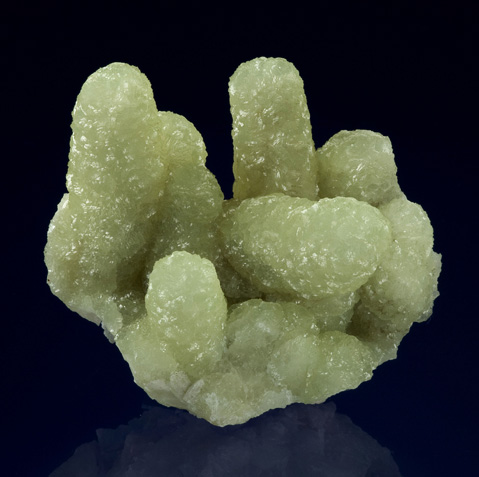The Mineral prehnite

Prehnite forms in both odd and distinct formation habits. It most often occurs as rounded or bubbly crystal masses, and commonly forms odd-shaped epimorphs after Anhydrite, Glauberite, and Laumontite. These epimorphs are remarkable for having hollow centers of a dissolved early-stage mineral. Elongated Prehnite formations are almost always rounded at the head and resemble fingers, and they are affectionately called "Prehnite Fingers" by collectors. A particularly desirable formation, known as a snakehead, describes an elongated Prehnite epimorph with a widened head.
Prehnite sometimes has a brown ferrous coating, which can be removed with chemicals. Some dealers treat specimens by oiling them with lubricants to enhance luster. Prehnite is named after Colonel Hendrik Von Prehn (1733–1785), a Dutch commander of the military forces of South Africa who brought Prehnite specimens from South Africa to Europe.
For additional information, see the gemstone section on Prehnite.
Chemical Formula
Ca2Al2Si3O12(OH)
Color
Light green, dark green, mint-green, yellowish-green, brownish-green, and bluish-green. Rarely brown, yellow, orange, pink, gray, white, or colorless.
Crystal System
Orthorhombic
Properties
Streak
White |
Hardness
6 - 6.5 |
Transparency
Transparent to translucent |
Specific Gravity
2.8 - 3.0 |
Luster
Vitreous, waxy, pearly |
Cleavage
1,1;3,1 |
Fracture
Uneven |
Tenacity
Brittle |
Crystal Habits
Most often as rounded, bubbly globular masses. These rounded masses are usually composed of small saddle-shaped crystals or radiating balls. Commonly botryoidal, reniform, encrusting, stalactitic, acicular, as rounded balls, and as finger-shaped formations. Individual crystals can sometimes be seen in rounded aggregates as curved wedge shaped crystals or rounded groups of blocky rectangles. Larger individual crystals, which are elongated dipyramidal and often with flattened terminations, as well flattened tabular, are very rare and found in only a few unique localities. An interesting habit is the "Roman Helmet", which is a hemispherical ball with a protruding rounded crystal arc developed in the center. Prehnite frequently forms an epimorph over other dissolved minerals, forming elongated rounded prisms and fingers as well as rounded, triangular-shaped crystals.
Uses
Prehnite is a highly desired mineral among collectors, especially intriguing well-shaped form and pseudomorphs. Prehnite is used as a minor gemstone.
Noteworthy Localities
Large and exceptional delicate masses of Prehnite epimorphs after Laumontite come from the Kandivali Quarry, Mumbai, India. Several new deposits of gemmy Prehnite have been found in China, especially at Qiaojia, Yunnan Province; and at the Hongquizhen Quarry, Meigu, Sichuan Province. In Australia, good Prehnite has come from Prospect and Mullaley, New South Wales.
Africa contains many outstanding sources of Prehnite. The most extensive and exploited are in the Kayes Region of Mali, where the Prehnite can be found in perfect thick and translucent formations associated with sharp dark Epidote. Specific Kayes deposits include Djouga (Bendoukou), Diakon, Sandare, and Sadiola. A highly transparent Prehnite form comes from the Merelani Hills, Arusha, Tanzania; and mint green Prehnite from the Goboseb Mountains, Brandberg District, Erongo, Namibia. An extremely odd and different form of Prehnite in bright orange acicular crystals comes from the Kalahari Manganese Fields of South Africa at the N'Chwaning Mines in Kuruman.
Europe has only a few notable occurrences of mineral. These include Bourg d'Oisans, Isère, France; and the Oficarsa Quarry, Carchelejo, Spain. A form of Prehnite totally different from all others was found in the the Jeffrey Quarry in Asbestos, Quebec, Canada, in the form of large, individual dipyarimdal and flattened dipyramidal crystals and clusters.
In the U.S., the most famous and well-known Prehnite localities are in northwestern New Jersey. Some of the finest examples of this mineral in all forms, especially botryoidal, hemispherical blobs, fingers and snakeheads, were found in the Upper and Lower New Street Quarries, Paterson, Passaic Co.; as well as Prospect Park, Passaic Co. Large rounded balls, sometimes with a yellowish hue, were found in the Millington Quarry, Somerset Co.; and triagular clusters of exceptional Glauberite casts came from Fanwood, Somerset Co.
Connecticut has good Prehnite in many of the basalt quarries, especially the O & G Quarry in Southbury, New Haven Co. (including rare white Prehnite); the O & G Quarry in Woodbury, Litchfield Co.; and the Roncari quarry, East Granby, Hartford Co. In Massachusetts, Prehnite associated with sharp black Babingtonite was found in the Lane Quarry, Westfield, Hampden Co.; and pale green tabular crystals were found in the Foote Lithium Mine, Cleveland Co., North Carolina.
Distingushing Similar Minerals
Smithsonite - Softer, effervescent in hydrochloric acid.
Hemimorphite - Heavier and softer.
Wavellite - Occurs in different environments.